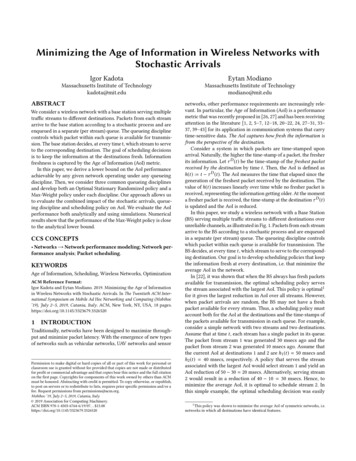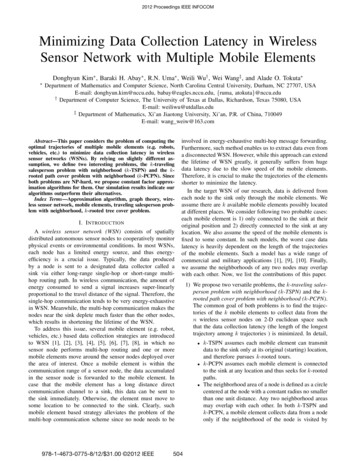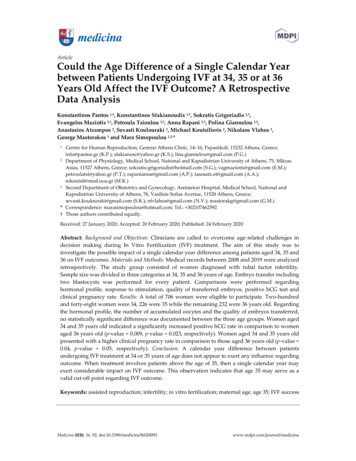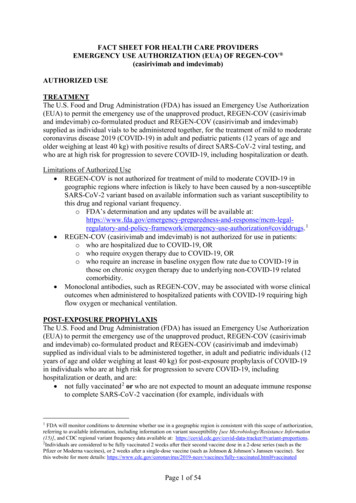
Transcription
Minimizing the Age of Information in Wireless Networks withStochastic ArrivalsIgor KadotaEytan ModianoMassachusetts Institute of Technologykadota@mit.eduMassachusetts Institute of Technologymodiano@mit.eduABSTRACTWe consider a wireless network with a base station serving multipletraffic streams to different destinations. Packets from each streamarrive to the base station according to a stochastic process and areenqueued in a separate (per stream) queue. The queueing disciplinecontrols which packet within each queue is available for transmission. The base station decides, at every time t, which stream to serveto the corresponding destination. The goal of scheduling decisionsis to keep the information at the destinations fresh. Informationfreshness is captured by the Age of Information (AoI) metric.In this paper, we derive a lower bound on the AoI performanceachievable by any given network operating under any queueingdiscipline. Then, we consider three common queueing disciplinesand develop both an Optimal Stationary Randomized policy and aMax-Weight policy under each discipline. Our approach allows usto evaluate the combined impact of the stochastic arrivals, queueing discipline and scheduling policy on AoI. We evaluate the AoIperformance both analytically and using simulations. Numericalresults show that the performance of the Max-Weight policy is closeto the analytical lower bound.CCS CONCEPTS Networks Network performance modeling; Network performance analysis; Packet scheduling.KEYWORDSAge of Information, Scheduling, Wireless Networks, OptimizationACM Reference Format:Igor Kadota and Eytan Modiano. 2019. Minimizing the Age of Informationin Wireless Networks with Stochastic Arrivals. In The Twentieth ACM International Symposium on Mobile Ad Hoc Networking and Computing (Mobihoc’19), July 2–5, 2019, Catania, Italy. ACM, New York, NY, USA, 18 ODUCTIONTraditionally, networks have been designed to maximize throughput and minimize packet latency. With the emergence of new typesof networks such as vehicular networks, UAV networks and sensorPermission to make digital or hard copies of all or part of this work for personal orclassroom use is granted without fee provided that copies are not made or distributedfor profit or commercial advantage and that copies bear this notice and the full citationon the first page. Copyrights for components of this work owned by others than ACMmust be honored. Abstracting with credit is permitted. To copy otherwise, or republish,to post on servers or to redistribute to lists, requires prior specific permission and/or afee. Request permissions from permissions@acm.org.Mobihoc ’19, July 2–5, 2019, Catania, Italy 2019 Association for Computing Machinery.ACM ISBN 978-1-4503-6764-6/19/07. . . ks, other performance requirements are increasingly relevant. In particular, the Age of Information (AoI) is a performancemetric that was recently proposed in [26, 27] and has been receivingattention in the literature [1, 2, 5–7, 12–18, 20–22, 24, 27–31, 33–37, 39–43] for its application in communication systems that carrytime-sensitive data. The AoI captures how fresh the information isfrom the perspective of the destination.Consider a system in which packets are time-stamped uponarrival. Naturally, the higher the time-stamp of a packet, the fresherits information. Let τ D (t) be the time-stamp of the freshest packetreceived by the destination by time t. Then, the AoI is defined ash(t) : t τ D (t). The AoI measures the time that elapsed since thegeneration of the freshest packet received by the destination. Thevalue of h(t) increases linearly over time while no fresher packet isreceived, representing the information getting older. At the momenta fresher packet is received, the time-stamp at the destination τ D (t)is updated and the AoI is reduced.In this paper, we study a wireless network with a Base Station(BS) serving multiple traffic streams to different destinations overunreliable channels, as illustrated in Fig. 1. Packets from each streamarrive to the BS according to a stochastic process and are enqueuedin a separate (per stream) queue. The queueing discipline controlswhich packet within each queue is available for transmission. TheBS decides, at every time t, which stream to serve to the corresponding destination. Our goal is to develop scheduling policies that keepthe information fresh at every destination, i.e. that minimize theaverage AoI in the network.In [22], it was shown that when the BS always has fresh packetsavailable for transmission, the optimal scheduling policy servesthe stream associated with the largest AoI. This policy is optimal1for it gives the largest reduction in AoI over all streams. However,when packet arrivals are random, the BS may not have a freshpacket available for every stream. Thus, a scheduling policy mustaccount both for the AoI at the destinations and the time-stamps ofthe packets available for transmission in each queue. For example,consider a simple network with two streams and two destinations.Assume that at time t, each stream has a single packet in its queue.The packet from stream 1 was generated 30 msecs ago and thepacket from stream 2 was generated 10 msecs ago. Assume thatthe current AoI at destinations 1 and 2 are h 1 (t) 50 msecs andh 2 (t) 40 msecs, respectively. A policy that serves the streamassociated with the largest AoI would select stream 1 and yield anAoI reduction of 50 30 20 msecs. Alternatively, serving stream2 would result in a reduction of 40 10 30 msecs. Hence, tominimize the average AoI, it is optimal to schedule stream 2. Inthis simple example, the optimal scheduling decision was easily1 This policy was shown to minimize the average AoI of symmetric networks, i.e.networks in which all destinations have identical features.
Mobihoc ’19, July 2–5, 2019, Catania, Italydetermined. In general, designing a transmission scheduling policythat keeps information fresh over time is a challenging task thatneeds to take into account the packet arrival process, the queueingdiscipline, and the conditions of the wireless channels.In recent years, the problem of minimizing the AoI has beenaddressed in a variety of contexts. Queueing Theory is used in [6, 7,16, 24, 27, 29, 31, 43] for finding the optimal server utilization withrespect to AoI. The authors in [1, 2, 35, 41] consider the problem ofoptimizing the times in which packets are generated at the sourcein networks with energy-harvesting or maximum update frequencyconstraints. Applications of AoI are studied in [3, 9, 23, 25, 26].Link scheduling optimization with respect to AoI has been recentlyconsidered in [4, 5, 8, 12–15, 18, 20–22, 28, 30, 33, 34, 36–40, 42].Next, we describe the mentioned related work on link schedulingoptimization.The authors in [5, 8, 37] studied multi-hop networks, while otherworks addressed single-hop networks. Deterministic packet arrivalswere considered in [8, 20–22, 28, 36–40, 42], arbitrary arrivals in[4, 5, 12, 13, 34] and stochastic arrivals in [14, 15, 18, 30, 33, 39].Networks with no queueing, i.e. when packets are discarded ifnot scheduled immediately upon arrival, were considered in [14,15], First-In First-Out (FIFO) queues were considered in [12, 13,18, 39] and other works considered Last-Generated First-Servedqueues, which are often equivalent to the simpler Last-In First-Out(LIFO) queues. Reliable links over which transmissions are alwayssuccessful are considered in [4, 5, 8, 12–15, 18, 33, 34, 37, 42] andother works considered unreliable links.Most relevant to this paper are [14, 18, 20, 21, 34, 39]. In [39], theauthors consider a network with stochastic packet arrivals, FIFOqueues and link scheduling following a Stationary Randomizedpolicy. An expression for the AoI in a discrete time G/Ber/1 queueis derived and used to develop a method of jointly tunning arrivaland service rates of all links in order to minimize AoI. In [34], theauthors develop scheduling policies for multi-server queueng systems in which streams have synchronized packet arrivals. In [14],the authors develop scheduling policies based on the Whittle’s Index for networks with stochastic arrivals, no queues and reliablebroadcast channels. The authors in [18] utilize an alternative definition of AoI to develop an Age-Based Max-Weight policy for anetwork with stochastic arrivals, FIFO queues and unreliable links.In [20, 21], the authors consider a network with deterministic arrivals, LIFO queues and unreliable broadcast channels, and developthree policies: Optimal Stationary Randomized, Whittle’s Index andAge-Based Max-Weight.In this paper, we develop a framework for addressing linkscheduling optimization in networks with stochastic packetarrivals and unreliable links operating under three commonqueueing disciplines. Our main contributions include: i) derivinga lower bound on the AoI performance achievable by any givennetwork operating under any queueing discipline; ii) developingboth an Optimal Stationary Randomized policy and an Age-BasedMax-Weight policy under three common queueing disciplines; andiii) evaluating the combined impact of the stochastic arrivals, queueing discipline and scheduling policy on AoI. We show that, contraryto intuition, the Optimal Stationary Randomized policy for LIFOqueues is insensitive to packet arrival rates. Simulation results showIgor Kadota and Eytan Modianothat the performance of the Age-Based Max-Weight policy for LIFOqueues is close to the analytical lower bound.This paper generalizes our earlier results in [20, 21]. The maindifference is that in [20, 21] we assume that when the BS selects astream, a new packet with fresh information is generated and thentransmitted to the corresponding destination in the same time-slot.It follows that in [20, 21] the packet delay is always 1 slot and the AoIis reduced to h(t) 1 slot after every packet delivery. In contrast, inthis paper, we consider a network in which packets are generatedaccording to a stochastic process and are enqueued before beingtransmitted. This seemingly modest distinction affects the packetdelay and the evolution of AoI over time, which in turn affects theresults and proofs throughout the paper significantly. For example,consider the analysis of Stationary Randomized policies. Under theassumptions in [20, 21], the AoI evolution is stochastically renewedafter every packet delivery, since h(t) 1, and thus the AoI can beanalyzed by directly applying the elementary renewal theorem forrenewal-reward processes. In contrast, in this paper, the evolutionof AoI may be dependent across consecutive inter-delivery intervalsand, thus, the same approach is not applicable. To analyze the AoI,we obtain the stationary distribution of a two-dimensional MarkovChain in Proposition 4.The remainder of this paper is organized as follows. In Sec. 2, wedescribe the network model. In Sec. 3 we derive an analytical lowerbound on the AoI minimization problem. In Sec. 4, we develop theOptimal Stationary Randomized policy for each queueing disciplineand characterize their AoI performance. In Sec. 5, we develop theMax-Weight policy and obtain performance guarantees in terms ofAoI. In Sec. 6, we provide numerical results. The paper is concludedin Sec. 7. Due to the space constraint, some of the technical proofsare provided in the report in [19].2SYSTEM MODELConsider a wireless network with a BS serving packets from Nstreams to N destinations, as illustrated in Fig. 1. Time is slottedwith slot index t {1, 2, · · · ,T }, where T is the time-horizon of thisdiscrete-time system. At the beginning of every slot t, a new packetfrom stream i {1, 2, · · · , N } arrives to the system with probabilityλi (0, 1], i. Let ai (t) {0, 1} be the indicator function that isequal to 1 when a packet from stream i arrives in slot t, and ai (t) 0otherwise. This Bernoulli arrival process is i.i.d. over time andindependent across different streams, with P(ai (t) 1) λi , i, t.Figure 1: Illustration of the wireless network.Packets from stream i are enqueued in queue i. Denote by Headof-Line (HoL) packets the set of packets from all queues that areavailable to the BS for transmission in a given slot t. Depending on
Minimizing the Age of Information in Wireless Networks with Stochastic Arrivalsthe queueing discipline employed by the network, queues can beof three types:(i) FIFO queues: packets are served in order of arrival. The HoLpackets in slot t are the oldest packets in each queue. This is astandard queueing discipline, widely deployed in communication systems. However, only a few works on link schedulingoptimization [12, 13, 18, 39] consider this queueing discipline;(ii) Single packet queues: when a new packet arrives, older packetsfrom the same stream are dropped from the queue. The HoLpackets in slot t are the freshest (i.e. most recently generated)packets in each queue. This queueing discipline is known tominimize the AoI in a variety of contexts. From the perspectiveof the AoI, Single packet queues are equivalent to LIFO queues;(iii) No queues: packets can be transmitted only duing the slot inwhich they arrive. The HoL packets in slot t are given by theset {i ai (t) 1}. This queueing discipline is considered in[14, 15] for its ease of analysis.Let zi (t) represent the system time of the HoL packet in queuei at the beginning of slot t. By definition, we have zi (t) : t τiA (t), where τiA (t) is the arrival time of the HoL packet in queue i.Naturally, the value of τiA (t) changes only when the HoL packetchanges, namely when the current HoL packet is served or droppedand there is another packet in the same queue; or when the queueis empty and a new packet arrives. Notice that zi (t) is undefinedwhen queue i is empty.We denote by ziF (t), ziS (t) and ziN (t), the system times associatedwith FIFO queues, Single packet queues and No queues, respectively.For all three cases, whenever the system time is defined, it evolvesaccording to the definition zi (t) : t τiA (t). Moreover, it followsfrom the description of the queueing disciplines that the evolutionof ziS (t) can be written as 0if ai (t) 1;ziS (t) (1)ziS (t 1) 1 otherwise,and the evolution of ziN (t) is such that ziN (t) 0 whenever anarrival occurs, i.e. ai (t) 1, and is undefined otherwise. In contrast,the evolution of ziF (t) cannot be simplified for it depends on boththe arrival times and service times of packets in the queue.In each slot t, the BS either idles or selects a stream and transmitsits HoL packet to the corresponding destination over the wirelesschannel. Let ui (t) {0, 1} be the indicator function that is equal to1 when the BS transmits the HoL packet from stream i during slott, and ui (t) 0 otherwise. The BS can transmit at most one packetat any given time-slot t. Hence, we haveÍN(2)i 1 ui (t) 1, t .The transmission scheduling policy governs the sequence of deciN of the BS.sions {ui (t)}i 1Let c i (t) {0, 1} represent the channel state associated withdestination i during slot t. When the channel is ON, we have c i (t) 1, and when the channel is OFF, we have c i (t) 0. The channelstate process is i.i.d. over time and independent across differentdestinations, with P(c i (t) 1) pi , i, t.Let di (t) {0, 1} be the indicator function that is equal to 1when destination i successfully receives a packet during slot t, anddi (t) 0 otherwise. A successful reception occurs when the HoLMobihoc ’19, July 2–5, 2019, Catania, Italypacket is transmitted and the associated channel is ON, implyingthat di (t) c i (t)ui (t), i, t. Moreover, since the BS does not knowthe channel states prior to making scheduling decisions, ui (t) andc i (t) are independent, and E[di (t)] pi E[ui (t)], i, t.The transmission scheduling policies considered in this paper arenon-anticipative, i.e. policies that do not use future information inmaking scheduling decisions. Let Π be the class of non-anticipativepolicies and let π Π be an arbitrary admissible policy. Our goal isto develop scheduling policies π that minimize the average AoI inthe network. Next, we formulate the AoI minimization problem.2.1Age of InformationThe AoI depicts how old the information is from the perspective ofthe destination. Let hi (t) be the AoI associated with destination iat the beginning of slot t. By definition, we have hi (t) : t τiD (t),where τiD (t) is the arrival time of the freshest packet delivered todestination i before slot t. If during slot t destination i receives apacket with system time zi (t) t τiA (t) such that τiA (t) τiD (t),then in the next slot we have hi (t 1) zi (t) 1. Alternatively, ifduring slot t destination i does not receive a fresher packet, then theinformation gets one slot older, which is represented by hi (t 1) hi (t) 1. Notice that the three queueing disciplines considered inthis paper select HoL packets with increasing freshness, implyingthat τiA (t) τiD (t) holds2 for every received packet. Hence, theAoI evolves as follows: zi (t) 1 if di (t) 1;hi (t 1) (3)hi (t) 1 otherwise,for simplicity, and without loss of generality, we assume that hi (1) 1 and zi (0) 0, i. Substituting ziF (t), ziS (t) and ziN (t) into (3) weobtain the AoI associated with FIFO queues, Single packet queuesand No queues, respectively. In Fig. 2 we illustrate the evolution ofhi (t) and zi (t) in a network employing Single packet queues.Figure 2: The blue and orange rectangles represent a packetarrival to queue i and a successful packet delivery to destination i, respectively. The blue curve shows the evolution ofzi (t) for the Single packet queue and the orange curve showsthe AoI associated with destination i.time-averageAoI associated with destination i is given by The ÍE Tt 1 hi (t) /T . For capturing the freshness of the informationof a network employing scheduling policy π Π, we define the2 One example of a queueing discipline that can violate τ A (t ) τ D (t ) is the LastiiIn First-Out (LIFO) queue. When an older packet with τiA (t ) τiD (t ) is delivered, theassociated AoI does not decrease and the network runs as if no packet was delivered.It follows that, from the perspective of the AoI, LIFO queues are equivalent to Singlepacket queues.
Mobihoc ’19, July 2–5, 2019, Catania, ItalyIgor Kadota and Eytan ModianoExpected Weighted Sum AoI (EWSAoI) in the limit as the timehorizon grows to infinity asT N 1 ÕÕw i E hiπ (t) ,(4)T T Nt 1 i 1where w i is a positive real number that represents the priority ofstream i. We denote by AoI-optimal, the scheduling policy π Πthat achieves minimum EWSAoI, namely E[J ] min E J π ,(5) E J π limNDefinition 1 (Stability Region). A set of arrival rates {λi }i 1is within the stability region of a given wireless network if there existsan admissible scheduling policy π Π that stabilizes all queues.where the expectation is with respect to the randomness in thechannel state c i (t), scheduling decisions ui (t) and arrival processai (t). Next, we introduce the long-term throughput and discuss thestability of FIFO queues.When the network is unstable under a policy η Π, then theexpected backlog of at least one of its queues grows indefinitely overtime. An infinitely large backlog leads to packets with infinitelylarge system times, i.e. zi (t) . It follows from the evolutionof hi (t) in (3) that the AoI also increases indefinitely and, as aresult, the Expected Weighted Sum AoI diverges, namely E[J η ] . Clearly, instability is a critical disadvantage for FIFO queues.Hence, we are interested in scheduling policies that can stabilize theN are within the stabilitynetwork whenever the arrival rates {λi }i 1region. Prior to introducing the policies, we derive a lower boundto the AoI minimization problem.2.23π ΠLong-term ThroughputÍ Tt 1 diπ (t) be the total number of packets deliveredto destination i by the end of the time-horizon T when the admissible policy π Π is employed. Then, the long-term throughputassociated with destination i is defined asE [D i (T )].(6)q̂iπ : limTT πThroughout this paper, we assume that q̂i 0, i. Since packetsfrom stream i are generated at a rate λi , the long-term throughputprovided to destination i cannot be higher than λi . Hence, thelong-term throughput satisfiesLet D iπ (T )q̂iπ λi , i .(7)The shared and unreliable wireless channel further restricts theN . By emset of achievable values of long-term throughput {q̂iπ }i 1ploying E[di (t)] pi E[ui (t)] and (2) into the definition of longterm throughput in (6), we obtain ÍN q̂ πÕE D iπ (T )pi Tt 1 E[uiπ (t)]i 1.(8)TTpi 1 iInequalities (7) and (8) are necessary conditions3 for the longN of any admissible scheduling policy π term throughput {q̂iπ }i 1Π, regardless of the queueing discipline. Both inequalities are usedfor deriving the lower bound in Sec. 3. Next, we discuss the stabilityof FIFO queues and its impact on the AoI minimization problem.2.3Queue StabilityQ iπ (t)Letbe the number of packets in queue i at the beginningof slot t when policy π is employed. Then, we say that queue i isstable if lim E Q iπ (T ) .(9)T A network is stable under policy π when all of its queues are stable.For networks with Single packet queues and No queues, stability istrivial since the backlogs are such that Q iπ (t) {0, 1}, t, regardlessof the scheduling policy. The discussion about queue stability thatfollows is meaningful only for the case of FIFO queues.3 In [20, 30], the authors consider destinations with minimum timely-throughputrequirements. Notice that conditions (7) and (8) are not throughput requirementsenforced by the destinations. They are necessary conditions that follow naturally fromthe stochastic arrivals and interference constraints of the network.LOWER BOUNDIn this section, we derive an alternative (and more insightful) expression for the AoI objective function J π in (4) in terms of packetdelay and inter-delivery times. Then, we use this expression toobtain a lower bound to the AoI minimization problem, namelyL B E[J ], for any given network operating under an arbitraryqueueing discipline. Surprisingly, the lower bound L B depends onlyon the network’s long-term throughput.3.1AoI in terms of packet delay andinter-delivery timesConsider a network employing policy π during the time-horizonT . Let Ω be the sample space associated with this network andlet ω Ω be a sample path. For a given sample path ω, let ti [m]be the index of the time-slot in which the mth (fresher4 ) packetwas delivered to destination i, m {1, · · · , D i (T )}, where D i (T )is the total number of packets delivered. Then, we define Ii [m] : ti [m] ti [m 1] as the inter-delivery time, with Ii [1] ti [1] andti [0] 0.The packet delay associated with the mth packet delivery todestination i is given by zi (ti [m]). Notice that zi (ti [m]) is the systemtime of the HoL packet at the time it is delivered to the destination,which is the definition of packet delay. To simplify notation, weuse zi [m] instead of zi (ti [m]).Define the operator M̄[x] that calculates the sample mean of aset of values x. Using this operator, the sample mean of Ii [m] for afixed destination i is given byM̄[Ii ] DÕi (T )1Ii [m] .D i (T ) m 1(10)For simplicity of notation, the time-horizon T is omitted in thesample mean operator M̄.Proposition 2. The infinite-horizon AoI objective function J πcan be expressed as follows"#N2Õw i M̄[Ii ] 2M̄[zi Ii ]J π lim 1 w.p.1 ,(11)2N M̄[Ii ]T M̄[Ii ]i 14 Recall that the delivery of an older packet with τ A (t ) τ D (t ) does not changeiithe associated AoI and, thus, should not be counted.
Minimizing the Age of Information in Wireless Networks with Stochastic Arrivalswhere Ii [m] is the inter-delivery time, zi [m] is the packet delay andM̄[zi Ii ] DÕi (T )1zi [m 1]Ii [m] .D i (T ) m 1(12)Proof. Provided in the technical report [19, Appendix A]. Equation (11) is valid for networks operating under an arbitraryqueueing discipline and employing any scheduling policy π Π. Asimilar result for the case of a single stream, N 1, was derivedin [17]. This equation provides useful insights into the AoI minimization. The first term on the RHS of (11), namely M̄[Ii2 ]/2M̄[Ii ],depends only on the service regularity provided by the schedulingpolicy. The second term on the RHS of (11) depends on both thepacket delay zi [m 1] and the inter-delivery time Ii [m], as followsDÕi (T )M̄[zi Ii ]Ii [m]zi [m 1] .(13) ÍDi (T )M̄[Ii ]m 1j 1 Ii [j]Notice that (13) is a weighted sample mean of the packet delays.Intuitively, for minimizing this term, both the queueing disciplineand the scheduling policy should attempt to deliver packets withlow delay zi [m 1] and, when the delay is high, they should deliverthe next packet as soon as possible in order to reduce the weightIi [m] on the weighted mean (13).The expression in (11) provides intuition on how the schedulingpolicy should manage the packet delays zi [m] and the inter-deliverytimes Ii [m] in order to minimize AoI. Moreover, it shows that byutilizing the simplifying assumption of queues always having freshpackets available for transmission, the scheduling policy disregardszi [m] and fails to address the term in (13). Next, we use (11) toobtain a lower bound to the AoI minimization problem and, inupcoming sections, we consider scheduling policies that take intoaccount both Ii [m] and zi [m].3.2Lower BoundA lower bound on AoI is obtained from the expression in Proposition 2. By applying Jensen’s inequality M̄[Ii2 ] (M̄[Ii ])2 to (11),manipulating the resulting expression and then employing a minimization over policies in Π, we obtainLower Bound N1 Õ1L B minwi π 1q̂iπ Π 2Ni 1ÍN πs.t. i 1 q̂i /pi 1 ;(q̂iπ λi , i ,)(14a)(14b)(14c)where (14b) and (14c) are the necessary conditions for the long-termthroughput in (8) and (7), respectively. Notice that the optimizationproblem in (14a)-(14c) depends only on the network’s long-termN and that the condition q̂ π λ limits thethroughput {q̂iπ }i 1iithroughput to the packet arrival rate of the respective stream. Tofind the unique solution to (14a)-(14c), we analyze the associatedKKT Conditions.Theorem 3 (Lower bound). For any given network with parameters (N , pi , λi , w i ) and an arbitrary queueing discipline, the optimization problem in (14a)-(14c) provides a lower bound on the AoIMobihoc ’19, July 2–5, 2019, Catania, Italyminimization problem, namely L B E[J ]. The unique solution to(14a)-(14c) is given by rw i pi, i ,(15)q̂iL B min λi ,2Nγ where γ yields from Algorithm 1. The lower bound is given by!N1 Õ1LB (16)wi L 1 .2N i 1q̂ BiAlgorithm 1 Solution to the Lower BoundÍN p1: γ̃ ( i 1w i /pi )2 /(2N ) and γi w i pi /2N λi2, i2: γ max{γ̃ ; γi }p3: qi λi min{1; γi /γ }, iÍN4: S i 1 qi /pi5: while S 1 and γ 0 do6:decrease γ slightly7:repeat steps 4 and 5 to update qi and S8: end whileL9: return γ γ and q̂i B qi , iProof. Provided in the technical report [19, Appendix B]. Next, we develop the Optimal Stationary Randomized policy fordifferent queueing disciplines and derive the closed-form expressionfor their AoI performance.4STATIONARY RANDOMIZED POLICIESDenote by Π R the class of Stationary Randomized policies. Let R Π R be a scheduling policy that, in each slot t, selects stream i withprobability µ i (0, 1] or selects no stream with probability µ 0 . Ifthe selected stream i has a non-empty queue, then ui (t) 1 and theHoL packet is transmitted by the BS to destination i. Alternatively,if the selected stream i has an empty queue or policy R selectedno stream, then ui (t) 0, i and the BS idles. The schedulingÍNprobabilities µ i are fixed over time and satisfy i 1µi 1 µ 0 .Randomized policies R Π R are as simple as possible. EachN . They selectpolicy in Π R is fully characterized by the set {µ i }i 1streams at random, without taking into account hi (t), zi (t) or queuebacklogs Q i (t). Notice that policies in Π R are not work-conserving,since they allow the BS to idle during slots in which HoL packetsare available for transmission.Despite their simplicity, we show that by properly tuning thescheduling probabilities µ i according to the network parameters(N , pi , λi , w i ), policies in Π R can achieve performances within afactor of 4 from the AoI-optimal. On the other hand, we also showthat naive choices of µ i can lead to poor AoI performances. Next,we develop and analyze scheduling policies for different queueingdisciplines which are optimal over the class Π R . In Secs. 4.1, 4.2and 4.3 we consider networks employing Single packet queues, Noqueues and FIFO queues, respectively. Then, in Sec. 4.4 we comparetheir AoI performances.
Mobihoc ’19, July 2–5, 2019, Catania, Italy4.1Igor Kadota and Eytan ModianoRandomized Policy for Single packet queueConsider a network employing the Single packet queue disciplineon N streams with packet arrival rates λi , priorities w i and channelreliabilities pi . Recall that for the Single packet queue, when a newpacket arrives, older packets from the same stream are dropped.The BS selects streams according to R Π R with scheduling probabilities µ i . Following a successful packet transmission from streami, its queue remains empty or a new packet arrives. The expectednumber of (consecutive) slots that queue i remains empty is 1/λi 1.When a new packet arrives, the BS transmits this packet with probability µ i . The expected number of slots necessary to successfullydeliver this packet is 1/pi µ i . Under policy R Π R and for the caseof Single packet queues, the sequence of packet deliveries is a renewal process. It follows from the elementary renewal theorem[10] thatT1Õ1E[di (t)] , i, t .1/pµ T Ti i 1/λi 1t 1lim(17)For the particular case of λi 1, the AoI process hi (t) is also
Consider a wireless network with a BS serving packets from N streams to N destinations, as illustrated in Fig. 1. Time is slotted with slot indext {1,2,···,T}, whereT is the time-horizon of this discrete-time system. At the beginning of every slot t, a new packet from streami {










